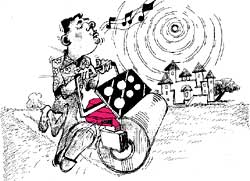Built to last
 the concept of sustainable development was launched into a sceptical world by the Brundtland Commission in the 80s and endorsed by the Rio Earth Summit. It is commonly said that nobody knows precisely what it means but everyone can grasp what it is about. Where has it got to? Who is actually trying to do it and not just talking about it and what does doing it entail? Most countries declared at Rio that they would draw up sustainable development strategies and so, made the concept officially conventional.
the concept of sustainable development was launched into a sceptical world by the Brundtland Commission in the 80s and endorsed by the Rio Earth Summit. It is commonly said that nobody knows precisely what it means but everyone can grasp what it is about. Where has it got to? Who is actually trying to do it and not just talking about it and what does doing it entail? Most countries declared at Rio that they would draw up sustainable development strategies and so, made the concept officially conventional.
Today, an industrialist or designer does not have to feel eccentric if he or she explores sustainability so there is now a good deal of experience and many groups of academics, designers and consultants and businessmen have applied themselves. A recent workshop at a Centre for Sustainable Design at the Surrey Institute of Art and Design in the uk provided a window on current activity. There is still a lot of philosophical clarification going on as in, for example, the distinction between eco-design and sustainable product design. It seems academic to make distinctions but a closer look at an example soon shows there are two very different underlying concepts.
An eco-lawnmower, say, is different from a sustainable lawnmower in significant respects. A throw-away lawnmower, cheaply made of materials that can be recycled and running on an economical four-stroke petrol engine with a catalyser, might qualify as an eco-design but no more than that. Something qualifying for the name sustainable might be a solar-powered lawnmower consuming no fuel, with a life expectancy of 40 years designed to be repaired very cheaply, perhaps progressively modified and passed from one generation to the next, and certainly never thrown away.
There are more subtleties beyond that distinction. The concept of the ecological rucksack is one. This focuses on the cost to the environment of treating the basic materials which contribute to a product and it provokes much reflection. Imagine that a millionaire decides to give his wife a gold lawnmower in appreciation of the fact that she has always done the garden while he was out making a fortune. After all, an English motor manufacturer gave his wife a gold plated Daimler just after the war and a Nigerian head of state gave his wife a gold bed, so why not? And gold does not corrode. But a kilogram of metal may require tonnes of materials to be moved and treated in the extraction process. Working out how much and not forgetting the quantities of fuel required shows that every kilo of gold and platinum require the deployment of 350,000 kg of other materials (1:350,000) to liberate them from Mother Nature. Better stop at chrome plating. Iron runs to a ratio of 1:14 but the zinc required to galvanise it scores 1:27. Cement has an ecological rucksack only 10 times greater than its own weight but, of course, its manufacture from limestone contributes a great deal of carbon dioxide to the atmosphere which has a different sort of impact on the environment.
In a sustainable future how should society choose on the grounds of sustainability between, say, a pre-stressed concrete bridge design and a steel one? How do you factor in concepts like the ecological rucksack to influence real decisions? How can the market then give the signals? Is a really free market more than an intellectual construct anyway? The more one looks into any real-life situation, the more complex and irresolvable the issues become. Among the more advanced academics it is now fashionable to express distaste for the concept of development and sustainable development is regarded as far too simple in a world which does not provide us with any lasting limits that we can point to with confidence.
However, as usual with philosophers, it is all very interesting but ordinary folk have no time to wait for the answer. In the real world of industrial design and manufacturing, where companies are ever more aware of environmental pressures and public opinion, sustainable development is taken seriously as an acceptable goal. Four evolutionary steps are seen in sustainable product design. First is the retro-fit, also known as the end of pipe fitment
Related Content
- Reply by Municipal Corporation, Ludhiana regarding parks and green belts, 31/12/2023
- The impact of disasters on agriculture and food security 2023: avoiding and reducing losses through investment in resilience
- Mobilizing investment for clean energy in India
- Heatwaves: addressing a sweltering risk in Asia-Pacific
- Order of the National Green Tribunal regarding violation of environmental norms for the project of Wave City at Ghaziabad and High-Tech City at NOIDA, 06/01/2022
- How Accessible Are Low-Income Neighbourhoods? The Case of Delhi
